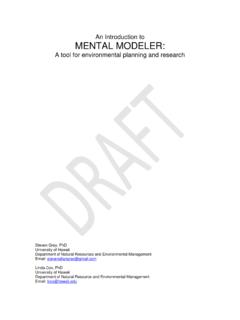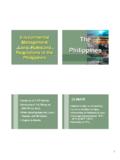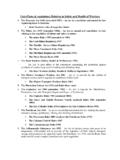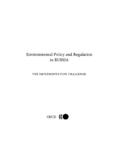Transcription of Mental Modeler: A Fuzzy-Logic Cognitive Mapping Modeling ...
1 Mental Modeler: A Fuzzy-Logic Cognitive Mapping Modeling Tool for Adaptive Environmental management Steven A. Gray Stefan Gray Linda J. Cox Sarah Henly-Shepard University of Hawaii Coastal & Marine Research Centre University of Hawaii University of Hawaii Abstract Participatory Modeling has grown in popularity in recent years with the acknowledgement that stakeholder knowledge is an essential component to informed environmental decision-making. Including stakeholders in model building and analysis allows decision-makers to understand important conceptualcomponents in the environmental systems being managed, builds trust and common understanding between potentially diverse sets of competing groups, and reduces uncertainty by mining information that might not otherwise be a part of scientific assessment performed by experts alone.
2 Software that facilitates the integration and analysis of stakeholder knowledge in Modeling , however, is currently lacking. In this paper we report on the design and anticipated use of a participatory Modeling tool based in Fuzzy-Logic Cognitive Mapping (FCM) called Mental Modeler which makes the Mental models of stakeholders explicit and provides an opportunity to incorporate different types of knowledge into environmental decision-making, define hypotheses to be tested, and run scenarios to determine perceived outcomes of proposed policies. 1. Introduction The importance of including stakeholders in environmental decision-making through Modeling has seen growing attention in recent years.
3 Voinov and Bousquet [1] outline two major objectives that drive participatory Modeling : (1) to increase and share knowledge and understanding of a system and its dynamics under various conditions [2, 3, 4] and (2) to identify and clarify the impacts of solutions to a given problem [5, 6, 7]. Currently a wide range of stakeholder-centered Modeling programs, practices, and guidelines exist, which all essentially aim to provide decision support and facilitation in participatory planning contexts. Although the tools and software available to environmental managers have experienced a large recent increase, some critics have cautioned that diversity of Modeling practicesdoes not necessarily indicate diversity in function, as new stakeholder Modeling programs are often prone to duplication of efforts [8].
4 Recent reviews of Modeling processes and tools have highlighted that community learning- by way of structured knowledge sharing- is the most significant benefit of including stakeholders in Modeling . Recommendations for future development focus on designing tools and processes that capitalize on learning as an outcome of participatory Modeling , specifically toward the goals of adaptive resource management through iterative model development [1]. In an effort to improve stakeholder-centered participatory Modeling , we present the architecture of Modeling software entitled Mental Modeler . The goal of developing this software is to facilitate user-centered model construction, promote learning in disparate stakeholder communities through knowledge sharing and allow flexibility for users to refine and test their models intended to facilitate adaptive management planning.
5 We first give an overview of the design framework of the software tool. Next we discuss the architectural structure of the software, including the three main user interfaces. Finally, we illustrate the potential use of the tool using data collected from a case study of adaptive coastal planning in southern Background and Design Framework Our design framework draws upon three distinct, but related, perspectives that include the role of Mental models in decision-making, the role of Modeling in adaptive management and Fuzzy-Logic Cognitive Mapping (FCM). Mental Models in Environmental Decision-making Participatory Modeling exists within a hierarchy, beginning at the individual Mental model level and extending to the systems level [8].
6 Mental models are internal constructs which provide interpretation 2013 46th Hawaii International Conference on System Sciences1530-1605/12 $ 2012 IEEEDOI 46th Hawaii International Conference on System Sciences1530-1605/12 $ 2012 IEEEDOI structure of an external environment and are therefore an important component in individual decision making [9]. First introduced by Craik [10] these internal representations are constructed as individuals modify their understanding of the world around them as they travel through time and space [11]. The ways in which different representations of the world are organized, socially influenced and usedfor understanding the rules associated with natural resource management has seen increasing attention in recent years [12, 13, 14, 15.]
7 16]. Shared Mental models in communities are essential as societies structure their environments and build expectations and are therefore an important part of an organized society, including the establishment of norms and laws which guide addition to being externally influenced through the continuous construction and revision of beliefs, Mental models also have the ability to influence and shape the environments which they interpret. Human agents, within the social and ecological systems of which they are a part, have the ability to alter their decisions and behaviors in light of anticipated changes to their perceived environment [17].
8 This anticipation of future social and ecological states often results in decisions and behaviors which seek to maximize changes which are deemed favorable, and decrease changes which are unfavorable. Mental models are therefore important constructs for understanding human interpretation of the external world as well as reference points that influence decisions and behaviors that affect the external world. Therefore, the understanding of social agents involved in environmental management through Mental Modeling , either evaluated individually or scaled up to characterize community knowledge, provides the basis of our tool s Modeling framework.
9 Modeling in Adaptive Environmental management Modeling has long been considered a vital component of adaptive management initiatives [18]. Walters [19] describes three central aims of Modeling in this context: (1) problem clarification and enhanced communication among scientists, managers, and other stakeholders; (2) policy screening to eliminate options that are most likely incapable of doing much good, because of inadequate scale or type of impact; and (3) identification of key knowledge gaps that make model predictions suspect. Researchers have typically sought to address these aims with the construction of very complex quantitative models which aspire to replicate the behavior and interaction of key elements and processes of the natural systems under study.
10 With such a model at their disposal, researchers anticipate that simplified, critical inner workings of environmental systems will be more readily communicable to diverse stakeholder audiences, and that the performance of a range of potential management interventions might be meaningfully interrogated without the need for costly and potentially risky experimentation with each management option in the field. However, the flaws in this approach have become increasingly apparent and problematic in real-world practice. Far from facilitating communication, a divide often arises between scientists who construct complex quantitative models and stakeholders who wish to express their typically qualitative views of how the system functions, and who must ultimately accept Modeling outputs in order to further adaptive management initiatives [20].






